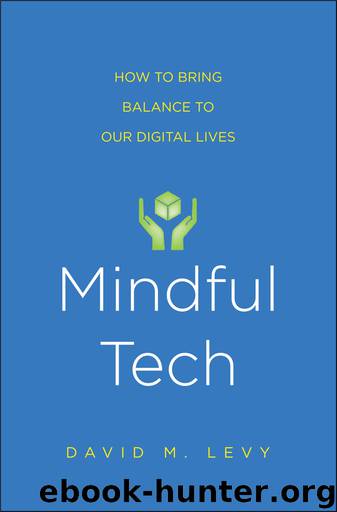Mindful Tech by David M. Levy

Author:David M. Levy [Levy, David M.]
Language: eng
Format: epub
Publisher: Yale University Press
Published: 2015-03-26T16:00:00+00:00
7
Exercise 4
Focused Multitasking
I learned that there really is a way to be an efficient, mindful and productive multitasker! . . . By setting manageable intentions before I engage in multitasking, I’m able to be kind to myself while also setting a goal. This creates a place where I am better able to focus on the tasks. By taking deep breaths, I remind myself of my intention and am able to kindly refocus and bring myself back to the task.
—Kathleen
I’m still not a big fan of multitasking and I don’t think that I will be engaging in a high-activity form of it with regularity. That said, the principles that I established for myself in this exercise have made the experience less frustrating. I certainly plan to adopt these strategies when I am in environments that force a degree of multitasking . . . or for times when I have a lot to accomplish and need to maintain my priorities.
—Samantha
I learned a great deal from Darlene Cohen about how to multitask in a more focused way. Darlene was a Bay Area Zen teacher, who for many years taught workshops on managing chronic illness and stress. During the dot-com boom in the late 1990s, tech workers came to her, asking her to help them work more productively and less stressfully. She began teaching workshops on “connecting with work in a deeply satisfying way,” which is the subtitle of the book she eventually published on the subject, The One Who Is Not Busy. I discovered Darlene’s work through this book, and quickly saw its relevance to my own research and teaching. In her workshops and her book she explored how we might work more effectively by training our attention and learning to shift our focus more fluidly. While reading her book, I saw the possibility of providing some experimental validation for these ideas.1
I contacted Darlene and explained my idea: to offer knowledge workers her training program, and to evaluate their ability to multitask both before and after the training. Darlene, it turned out, had a master’s degree in neuroscience and had worked as an assistant in the Harvard laboratory of the psychologist B. F. Skinner. She was intrigued by the idea for the study and was interested in participating. With funding from the National Science Foundation and the MacArthur Foundation, and in collaboration with Jacob O. Wobbrock (a human-computer interaction researcher at the University of Washington Information School), Alfred Kaszniak (a neuropsychologist at the University of Arizona), and Marilyn Ostergren (a doctoral student at the UW Information School), I was able to recruit human resource managers from Seattle and San Francisco, train them, and test their multitasking ability.
Some of the human resource managers were trained by Darlene herself, or by one of her senior students. They received eight weeks of instruction in attention training. A second group received eight weeks of instruction in body relaxation. The third group, the waitlist control group, received no training for the initial eight-week period but was subsequently given attention training and tested again.
Download
This site does not store any files on its server. We only index and link to content provided by other sites. Please contact the content providers to delete copyright contents if any and email us, we'll remove relevant links or contents immediately.
Cecilia; Or, Memoirs of an Heiress — Volume 1 by Fanny Burney(32503)
Cecilia; Or, Memoirs of an Heiress — Volume 2 by Fanny Burney(31913)
Cecilia; Or, Memoirs of an Heiress — Volume 3 by Fanny Burney(31898)
The Great Music City by Andrea Baker(31759)
We're Going to Need More Wine by Gabrielle Union(19004)
All the Missing Girls by Megan Miranda(15784)
Pimp by Iceberg Slim(14438)
Bombshells: Glamour Girls of a Lifetime by Sullivan Steve(14024)
For the Love of Europe by Rick Steves(13627)
Talking to Strangers by Malcolm Gladwell(13297)
Norse Mythology by Gaiman Neil(13281)
Fifty Shades Freed by E L James(13189)
Mindhunter: Inside the FBI's Elite Serial Crime Unit by John E. Douglas & Mark Olshaker(9266)
Crazy Rich Asians by Kevin Kwan(9224)
The Lost Art of Listening by Michael P. Nichols(7456)
Enlightenment Now: The Case for Reason, Science, Humanism, and Progress by Steven Pinker(7274)
The Four Agreements by Don Miguel Ruiz(6704)
Bad Blood by John Carreyrou(6584)
Weapons of Math Destruction by Cathy O'Neil(6220)
